2012 PEUGEOT 4007 ECU
[x] Cancel search: ECUPage 113 of 236
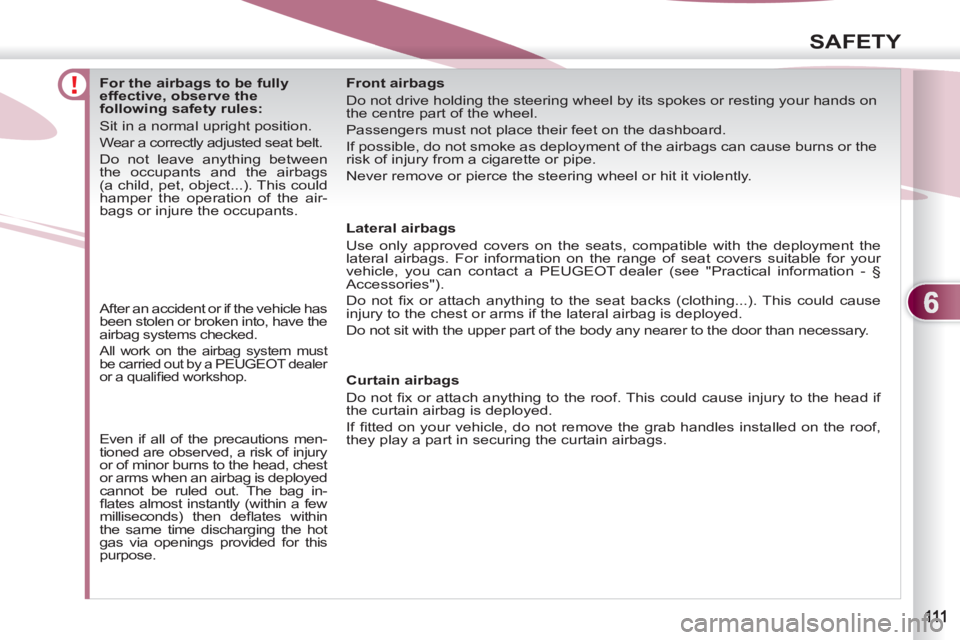
6
SAFETY
For the airbags to be fully
effective, observe the
following safety rules:
Sit in a normal upright position.
Wear a correctly adjusted seat belt.
Do not leave anything between
the occupants and the airbags
(a child, pet, object...). This could
hamper the operation of the air-
bags or injure the occupants.
Lateral airbags
Use only approved covers on the seats, compatible with the deployment the
lateral airbags. For information on the range of seat covers suitable for your
vehicle, you can contact a PEUGEOT dealer (see "Practical information - §
Accessories").
Do not fi x or attach anything to the seat backs (clothing...). This could cause
injury to the chest or arms if the lateral airbag is deployed.
Do not sit with the upper part of the body any nearer to the door than necessary. After an accident or if the vehicle has
been stolen or broken into, have the
airbag systems checked.
All work on the airbag system must
be carried out by a PEUGEOT dealer
or a qualifi ed workshop.
Even if all of the precautions men-
tioned are observed, a risk of injury
or of minor burns to the head, chest
or arms when an airbag is deployed
cannot be ruled out. The bag in-
fl ates almost instantly (within a few
milliseconds) then defl ates within
the same time discharging the hot
gas via openings provided for this
purpose.
Front airbags
Do not drive holding the steering wheel by its spokes or resting your hands on
the centre part of the wheel.
Passengers must not place their feet on the dashboard.
If possible, do not smoke as deployment of the airbags can cause burns or the
risk of injury from a cigarette or pipe.
Never remove or pierce the steering wheel or hit it violently.
Curtain airbags
Do not fi x or attach anything to the roof. This could cause injury to the head if
the curtain airbag is deployed.
If fi tted on your vehicle, do not remove the grab handles installed on the roof,
they play a part in securing the curtain airbags.
Page 128 of 236
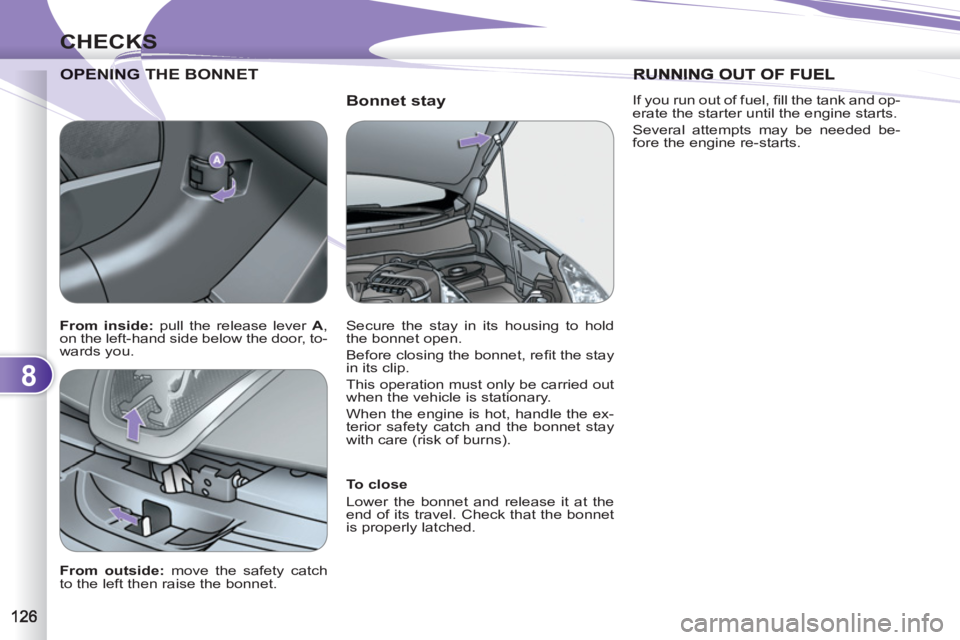
8
CHECKS
Bonnet stay
ENING THE BONNET
OPENING T
To close
Lower the bonnet and release it at the
end of its travel. Check that the bonnet
is properly latched.
From outside:
move the safety catch
to the left then raise the bonnet. Secure the stay in its housing to hold
the bonnet open.
Before closing the bonnet, refi t the stay
in its clip.
This operation must only be carried out
when the vehicle is stationary.
When the engine is hot, handle the ex-
terior safety catch and the bonnet stay
with care (risk of burns).
RUNNING
From inside:
pull the release lever A
,
on the left-hand side below the door, to-
wards you.
If you run out of fuel, fi ll the tank and op-
erate the starter until the engine starts.
Several attempts may be needed be-
fore the engine re-starts.
Page 137 of 236
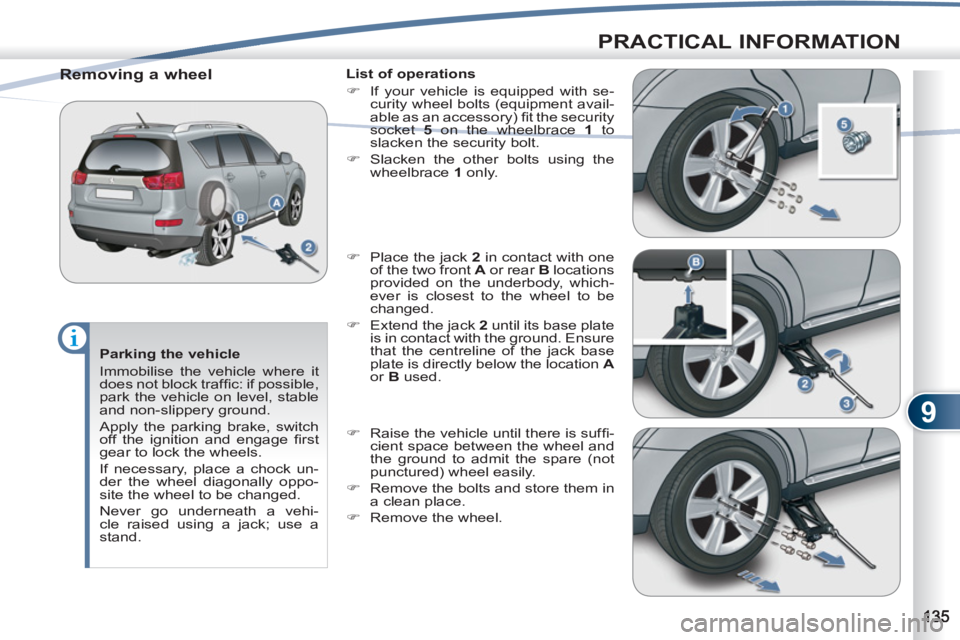
9
PRACTICAL INFORMATION
Parking the vehicle
Immobilise the vehicle where it
does not block traffi c: if possible,
park the vehicle on level, stable
and non-slippery ground.
Apply the parking brake, switch
off the ignition and engage fi rst
gear to lock the wheels.
If necessary, place a chock un-
der the wheel diagonally oppo-
site the wheel to be changed.
Never go underneath a vehi-
cle raised using a jack; use a
stand.
Removing a wheel
List of operations
�)
If your vehicle is equipped with se-
curity wheel bolts (equipment avail-
able as an accessory) fi t the security
socket 5 on the wheelbrace 1
to
slacken the security bolt.
�)
Slacken the other bolts using the
wheelbrace 1
only.
�)
Place the jack 2
in contact with one
of the two front A
or rear B
locations
provided on the underbody, which-
ever is closest to the wheel to be
changed.
�)
Extend the jack 2
until its base plate
is in contact with the ground. Ensure
that the centreline of the jack base
plate is directly below the location A
or B
used.
�)
Raise the vehicle until there is suffi -
cient space between the wheel and
the ground to admit the spare (not
punctured) wheel easily.
�)
Remove the bolts and store them in
a clean place.
�)
Remove the wheel.
Page 138 of 236
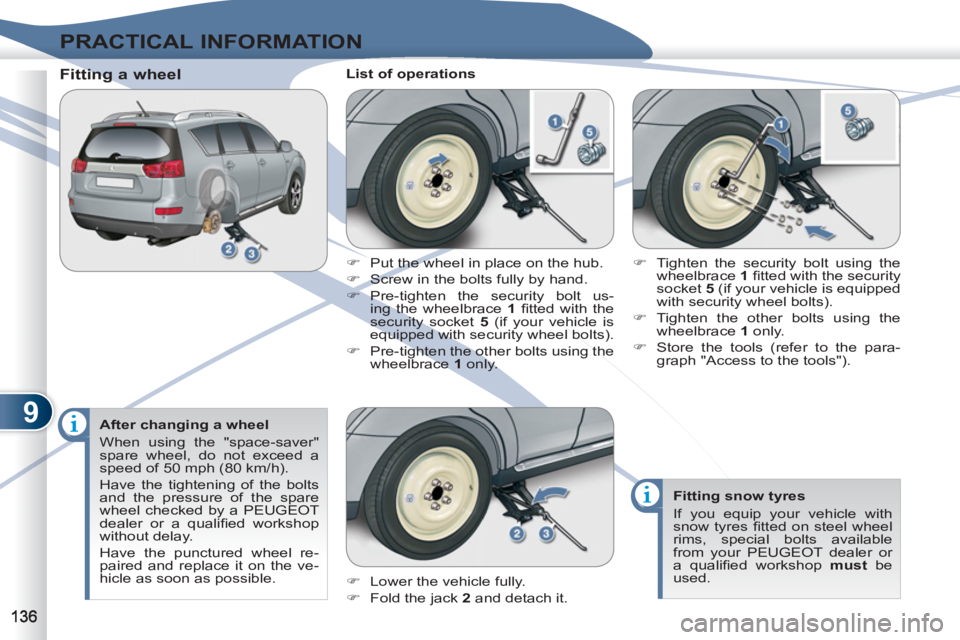
9
PRACTICAL INFORMATION
After changing a wheel
When using the "space-saver"
spare wheel, do not exceed a
speed of 50 mph (80 km/h).
Have the tightening of the bolts
and the pressure of the spare
wheel checked by a PEUGEOT
dealer or a qualifi ed workshop
without delay.
Have the punctured wheel re-
paired and replace it on the ve-
hicle as soon as possible.
Fitting a wheel
List of operations
�)
Lower the vehicle fully.
�)
Fold the jack 2
and detach it.
�)
Tighten the security bolt using the
wheelbrace 1
fi tted with the security
socket 5
(if your vehicle is equipped
with security wheel bolts).
�)
Tighten the other bolts using the
wheelbrace 1
only.
�)
Store the tools (refer to the para-
graph "Access to the tools").
Fitting snow tyres
If you equip your vehicle with
snow tyres fi tted on steel wheel
rims, special bolts available
from your PEUGEOT dealer or
a qualifi ed workshop must
be
used.
�)
Put the wheel in place on the hub.
�)
Screw in the bolts fully by hand.
�)
Pre-tighten the security bolt us-
ing the wheelbrace 1
fi tted with the
security socket 5 (if your vehicle is
equipped with security wheel bolts).
�)
Pre-tighten the other bolts using the
wheelbrace 1
only.
Page 149 of 236

9
PRACTICAL INFORMATION
Engine compartment fuses
The fusebox is placed in the engine compartment near the
battery (left-hand side).
Access to the fuses
�)
Open the bonnet (refer to the "Access" section),
�)
Press on the hook A
to release the catch,
�)
Remove the cover completely,
�)
Change the fuse (refer to the corresponding paragraph),
�)
When you have fi nished, close the cover carefully to en-
sure sealing of the fusebox.
Fuse N°
Rating
Functions
1
15 A
Front foglamps.
2
7 A
Engine ECU 2.4 litre 16 V
3
20 A
CVT automatic gearbox ECU, CVT
automatic gearbox relay
4
10 A
Horn.
5
7.5 A
Alternator 2.4 litre 16V
6
20 A
Headlamp wash.
7
10 A
Air conditioning.
8
15 A
Engine ECU 2.4 litre 16 V
9
-
Not used.
10
15 A
Demisting, wipers.
11
-
Not used.
12
-
Not used.
13
-
Not used.
14
10 A
Left-hand main beam headlamp.
15
10 A
Right-hand main beam headlamp.
16
20 A
Left-hand dipped beam headlamp (xenon).
17
20 A
Right-hand dipped beam headlamp (xenon).
18
10 A
Left-hand dipped beam headlamp, manual
and automatic headlamp adjustment.
19
10 A
Right-hand dipped beam headlamp.
20
-
Not used.
21
10 A
Ignition coils
Page 151 of 236
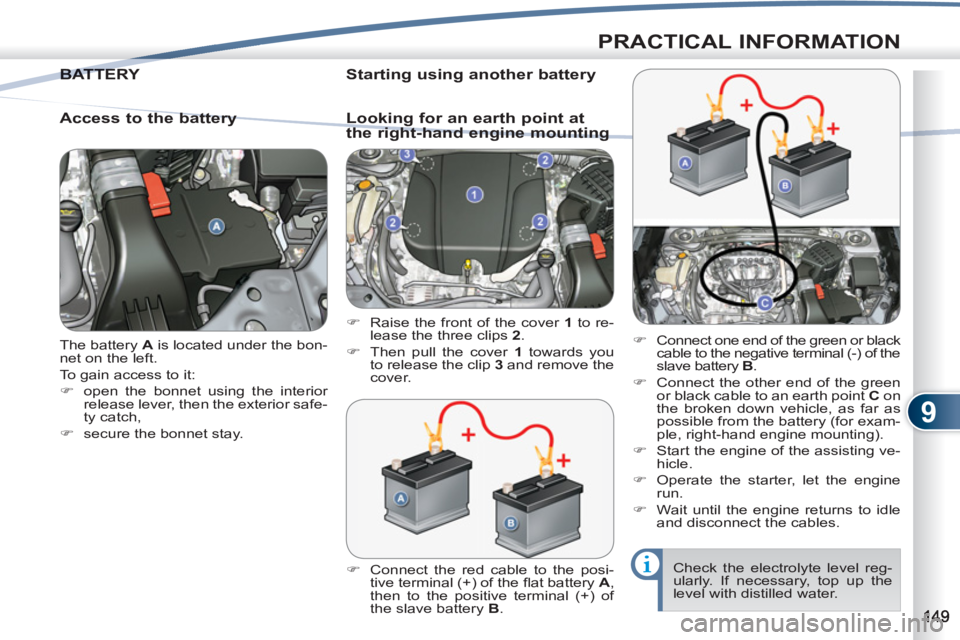
9
PRACTICAL INFORMATION
The battery A
is located under the bon-
net on the left.
To gain access to it:
�)
open the bonnet using the interior
release lever, then the exterior safe-
ty catch,
�)
secure the bonnet stay.
BATTERYBATTE
Access to the battery
�)
Connect the red cable to the posi-
tive terminal (+) of the fl at battery A
,
then to the positive terminal (+) of
the slave battery B
.
�)
Connect one end of the green or black
cable to the negative terminal (-) of the
slave battery B
.
�)
Connect the other end of the green
or black cable to an earth point C
on
the broken down vehicle, as far as
possible from the battery (for exam-
ple, right-hand engine mounting).
�)
Start the engine of the assisting ve-
hicle.
�)
Operate the starter, let the engine
run.
�)
Wait until the engine returns to idle
and disconnect the cables.
�)
Raise the front of the cover 1
to re-
lease the three clips 2
.
�)
Then pull the cover 1
towards you
to release the clip 3
and remove the
cover.
Check the electrolyte level reg-
ularly. If necessary, top up the
level with distilled water.
Starting using another battery
Looking for an earth point at
the right-hand engine mounting
Page 158 of 236

9
PRACTICAL INFORMATION
"Comfort":
rear parking sensors, side sun blinds,
insulated module...
"Style":
"Security and safety":
"Protection":
"Multimedia":
PVC door sill protectors, style rear
mudfl aps, Hortaz 18 inch alloy wheels,
chromed door handle shells, diffuser on
rear bumper, brushed aluminium look
boot sill protector... anti-intrusion alarm, glass etching,
wheel security bolts, fi rst aid kit, warn-
ing triangle, high visibility vest, stolen
vehicle tracking system, child seats and
booster cushions, under-infl ation detec-
tion, anti-slip covers...
mat * , side protective mouldings...
MP3/USB audio systems, audio-tele-
phone, amplifi ers, satellite navigation
systems, hands-free kit, speakers, DVD
player, connection kit for MP3 player or
portable CD player...
Installation of radio
communication transmitters
Before installing any after-
market radio communication
transmitter, you can contact a
PEUGEOT dealer for the speci-
fi cation of transmitters which
can be fi tted (frequency, maxi-
mum power, aerial position, spe-
cifi c installation requirements),
in line with the Vehicle Electro-
magnetic Compatibility Directive
(2004/104/EC).
"Transports solutions":
boot liner, dog guard, roof bars, bicycle
carrier for roof bars, ski carrier, roof
box...
Trailer towbar which must be fi tted by a
PEUGEOT dealer or a qualifi ed work-
shop.
ACCESCESSORIES
A wide range of accessories and genu-
ine parts is available from the PEUGEOT
dealer network.
These accessories and parts have
been tested and approved for reliability
and safety.
They are all adapted to your vehicle
and benefi t from PEUGEOT's recom-
mendation and warranty.
Depending on the legislation in
force in the country, it may be
compulsory to have a high vis-
ibility safety vest, warning trian-
gle and spare bulbs and fuses
available in the vehicle.
The fi tting of electrical equipment
or accessories which are not rec-
ommended by PEUGEOT may
result in a failure of your vehicle's
electronic system and excessive
electrical consumption.
Please note this precaution.
You are advised to contact a
PEUGEOT representative to be
shown the range of recommend-
ed equipment and accessories.
*
To prevent any risk of jamming of the
pedals:
- ensure that the mat is positioned
and secured correctly,
- never fi t one mat on top of another.